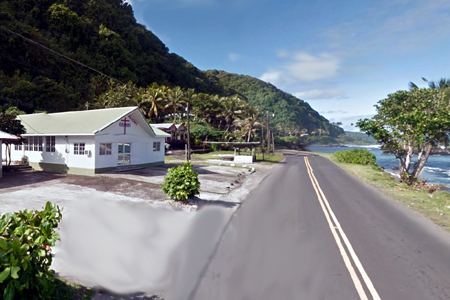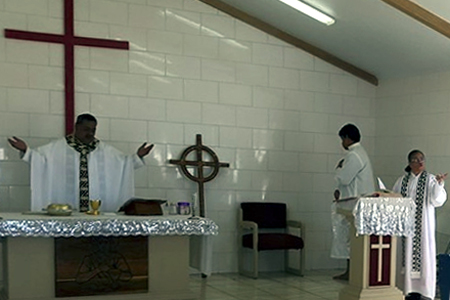| |
 |
 |
 |
| Comment on this report, or find other reports. |
 |
| Our Mystery Worshippers are volunteers who warm church pews for us around the world. If you'd like to become a Mystery Worshipper, start here. |
 |
| Find out how to reproduce this report in your church magazine or website. |
|
|
| 2818: St John's, Lauli'i, American Samoa |
 |
 |
 |
Mystery Worshipper: Meet and Right So to Do.
The church: St John's, Lauli'i, American Samoa.
Denomination: Anglican Church in Aotearoa, New Zealand and Polynesia, Diocese of Polynesia.
The building: A relatively simple hall-style church surrounded by rather typical Samoan family houses. The nondescript building consists of a small narthex and a sanctuary-style nave. The chancel contains a freestanding altar, elevated by one step. The interior is ordered with both a pulpit and epistle side lectern. However, only the lectern was used for the readings and sermon. The tile flooring has a faux marble finish to it. The walls, which look recently painted, are solid white without any decoration. A simple but elegant wooden cross adorns the east wall.
The church: St John's is unique in that it is seemingly the only Anglican Communion church – excluding the breakaway Anglican churches in communion with Canterbury – within the confines of the United States not under the jurisdiction of the Episcopal Church.
The neighborhood: American Samoa consists of five small volcanic islands and two coral atolls that make up the easternmost part of the Samoan archipelago. Located in the South Pacific Ocean, the archipelago lies about 2000 miles northeast of Auckland, New Zealand. American Samoa is a full 24 hours behind Samoa proper, as it is located just on the other side of the International Date Line. Tutuila, the largest island, includes the territory's capital, Pago Pago. Persons born in American Samoa are US nationals, with the right to reside in the United States, but are not citizens unless at least one of their parents is a citizen. Most American Samoans are bilingual and can speak English and Samoan fluently. The island's Christian religiosity is vibrant, with Congregationalists being the all-but-established state church, followed by Mormons and Roman Catholics. Pentecostal and Methodist congregations are also numerous in number. Anglicans are decidedly in the minority. The island's economy relies heavily on the tuna industry, with Star Kist Tuna exporting several hundred million dollars worth of canned tuna to the United States each year. The village of Lauli'i lies east of Pago Pago across the harbor and is reachable via a 15 minute drive by car (without traffic) around the shoreline. The view of the harbor from in front of the church is quite breathtaking. While some businesses are now open on Sundays, the island is practically a ghost town until late afternoon.
The cast: The Venerable Taifai To’omaata, Archdeacon of American Samoa, wearing a tropical-weight white alb and green chasuble adorned with Pacific leafs, celebrated. The Revd Amy Blizzard led the intercessions. Another unnamed woman priest gave the readings and delivered the sermon. Both wore tropical-weight white albs and seasonal green stoles, and both were barefoot. A teenage girl, also wearing the same style alb and also barefoot, served as crucifer, carrying a Celtic processional cross.
The date & time: Sunday, September 6, 2015, 9.00am.
What was the name of the service?
Eucharist.
How full was the building?
About 80 per cent of the 50 or so chairs were occupied. A considerable number of the congregation were children with adults who were presumably their mothers or grandmothers. Noticeably absent were men, which may be explained by American Samoa having the highest per capita enlistment rate in the US military. The few visitors to the island who are Anglican probably don't attend services because the church isn't located near the island's three hotels.
Did anyone welcome you personally?
One of the assisting priests gave me a warm welcome at the end of the service during the announcements. Every other congregant pretty much shook my hand and greeted me during the peace, which is a long liturgical affair at St John's, as every congregant shakes and embraces each other with Christian warmth and affection.
Was your pew comfortable?
The church is experimenting between having chairs and pews. The chairs, while not visually attractive, were actually quite comfortable, although there were no kneelers available for use in the liturgy.
How would you describe the pre-service
atmosphere?
Fairly social, with many congregants catching up with each other.
What were the exact opening words of the
service?
"Let us begin the mass."
What books did the congregation use during the
service?
No hymnals or prayer books were readily accessible, though I was given a service leaflet containing the English and Samoan liturgical texts. Most of the congregants had brought a Bible and many had what appeared to be a bound version of the provincial prayer book. For this service, the liturgy was primarily in English. Only the readings, including the gospel, sermon and hymns, were in Samoan.
What musical instruments were played?
A Yamaha Clavinova digital keyboard, located just beneath the epistle side lectern, was played by the stereotypical Samoan church lady.
Did anything distract you?
The New Zealand liturgy, combined with the bilingualism of the service, was confusing. While the modernism of the liturgy wasn't unfamiliar for anyone who has sat through a service using any of the Rite II forms from the 1979 American Book of Common Prayer, it was different enough that I had to pay careful attention. My occasional thee and thou, as well as "quick and the dead," apparently distracted a couple of the locals who looked at me with bemusement whenever I reverted to traditional Anglican liturgy. I was also slightly surprised by the quick pace of the service, as it felt a bit rushed.

Was the worship stiff-upper-lip, happy clappy, or
what?
It's difficult to assess given that the New Zealand church is known for having some unique cultural influences on its liturgy and churchmanship. St John's could very well be considered broad or high church for Samoan Anglicanism, but I suspect this is more toward the evangelical end of the Anglican worship spectrum. The archdeacon spoke in a deep, rich voice; I was disappointed that he didn't chant the liturgy, as I would have loved to have heard his singing voice. None of the hymns, which were all sung in Samoan, were familiar to my ears. The first two scripture readings were responsive: the Revd Mrs Blizzard would read a line or two, and the people then replied with the next few lines, referring to their Bibles. She read the gospel from the lectern on the epistle side, with the crucifer standing in the aisle holding the processional cross. Both priests helped the archdeacon with distribution of communion.
Exactly how long was the sermon?
10 minutes.
On a scale of 1-10, how good was the preacher?
5 – The preacher spoke in Samoan, which I don't understand. The other congregants didn't seem particularly interested, as none were visibly paying attention. Most were fidgeting or daydreaming. Even the archdeacon fell asleep – see below.
In a nutshell, what was the sermon
about?
Can't say.
Which part of the service was like being in
heaven?
Samoans of all denominations are known for their voices. The singing from the congregants made up for a digital keyboard and the lack of an organ.
And which part was like being in... er... the other place?
The archdeacon sleeping through the entire sermon plus the saying of the creed. I was afraid he would forget to celebrate, but he awoke on cue and carried out his role masterfully. In his defense, he had literally just arrived home after taking four miserable flights back from a Holy Land pilgrimage. I give him credit for showing up, but the sleeping was noticeable. How he managed to hold back the snoring was beyond me.
What happened when you hung around after the service looking lost?
The archdeacon engaged me in polite conversation, apologizing for there being no after-service coffee available (I'll bet he would have loved a good strong cup!). Several other congregants welcomed me as well. One congregant joked that the ingredients in the all-natural insect repellent – American Samoa is in the midst of a dengue fever epidemic – sounded like a good Anglican cocktail.
How would you describe the after-service
coffee?
See above.
How would you feel about making this church your regular (where 10 = ecstatic, 0 = terminal)?
5 – I'm not Roman Catholic and I like my liturgy, so St John's would be pretty much the only option for me if I lived on the island. But if that happened I would want an all-English service, which might bring in some of the admittedly very small ex-pat community, including many of the seamen passing through Pago Pago's busy port.
Did the service make you feel glad to be a
Christian?
Yes. The congregation couldn't have been more friendly. They seemed genuinely warm and, I think, surprised to have a mainland visitor, as tourism in American Samoa is non-existent. It certainly served as an example of the church's universal nature and the diversity of the Anglican Communion.
What one thing will you remember about all this in seven days' time?
The simpleness of the church. So many good Anglicans place a certain emphasis on church architecture and furnishings while ignoring the necessity to spread the good news. |
|
|
 |
 |
 |
| We rely on voluntary donations to stay online. If you're a regular visitor to Ship of Fools, please consider supporting us. |
 |
 |
 |
| The Mystery Pilgrim |
 |
| One of our most seasoned reporters makes the Camino pilgrimage to Santiago de Compostela in Spain. Read here. |
 |
 |
 |
| London churches |
 |
| Read reports from 70 London churches, visited by a small army of Mystery Worshippers on one single Sunday. Read here. |
| |
|
|
|
|


